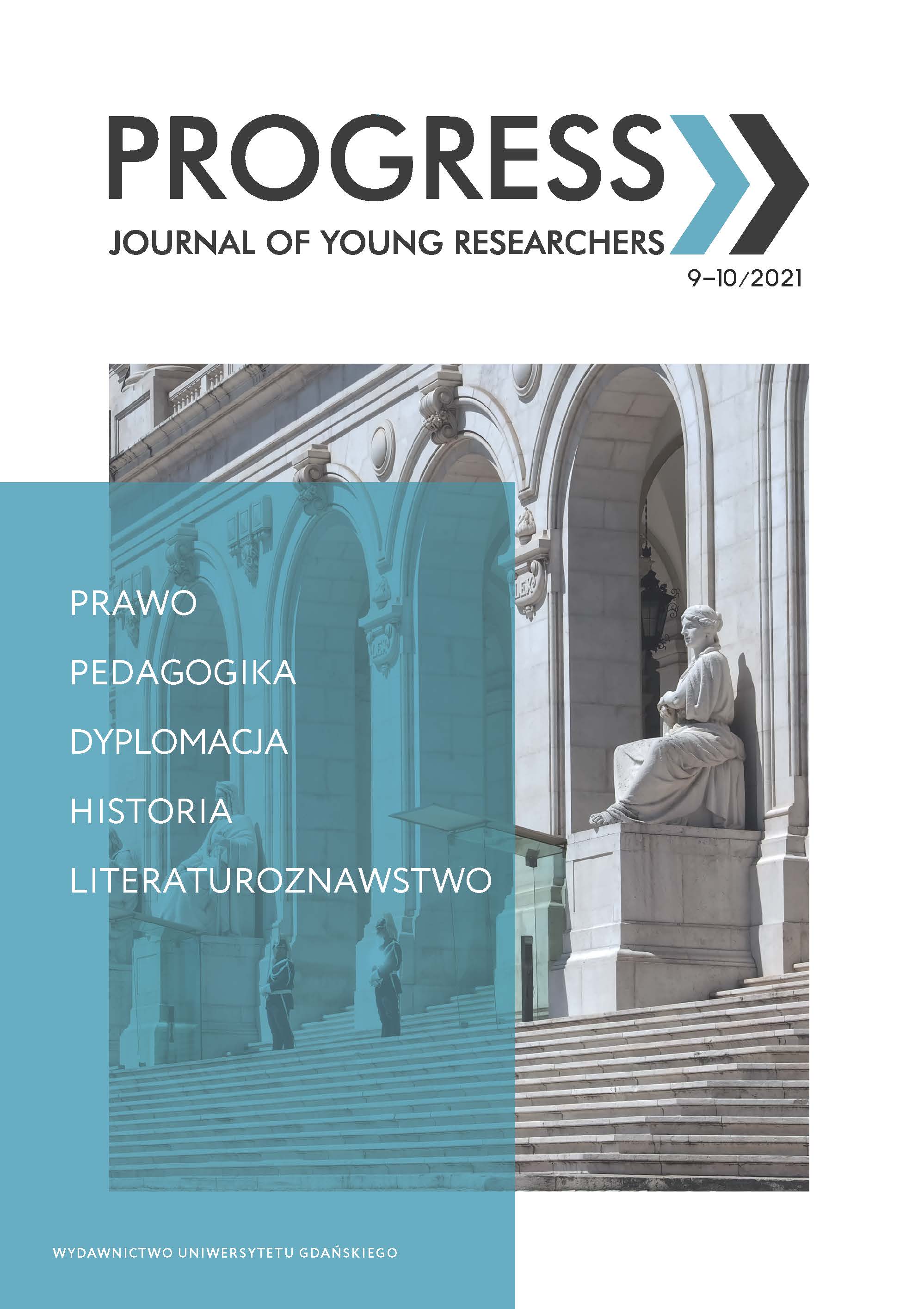The relationship between art education and the physical and mental health of the elderly in Poland and abroad
DOI:
https://doi.org/10.26881/prog.2021.10.03Keywords:
elderly people, music education, dance education, choreotherapy, art therapy, music therapyAbstract
The author of the article discusses the impact of artistic activities on the physical and mental health of elderly people. She describes the correlation between music and dance and the well-being and mental development of seniors. Both Poland and other countries organize classes in choreotherapy, art therapy and music therapy to support this social group. The author pays special attention to the functions of artistic activities and their importance for human health. In this article, she presents three forms of therapy for seniors which are organized in Poland and abroad: choreotherapy, art therapy, and music therapy. The article also includes descriptions of government programmes designed to support active older adults.
Downloads
References
Baltes M.M., Lang F.R., 1997, Everyday functioning and successful aging: the impact of resources, “Psychology and Aging”, Vol. 12, No. 3.
Berk L., 2004, Development through the lifespan, Boston.
Fisher B., Specht D., 1999, Successful aging and creativity later in life, “Journal of Aging Studies”, Vol. 13, No. 4.
Banio A., Banio-Surmiak J., 2017, Wpływ zajęć tanecznych na wzrost jakości życia osób starszych [Influence of dance classes on the increase in the quality of the elderly’s life], “Handel Wewnętrzny”, Vol. 4, No. 2.
Flood M., Philips K.D., 2007, Creativity in older adults: A plethora of possibilities, “Issues in Mental Health Nursing”, Vol. 28, No. 4.
Gazeta Prawna, 2019, NIK: Rządowy program aktywizujący seniorów nie osiągnął celu [NIK: Government program to activate seniors has not achieved its goal], 22.10.2019, https://praca.gazetaprawna.pl/artykuly/1436174,nik-rzadowy-program-aktywizujacy-seniorow-nie-osiagnal-celu.html [access: 21.03.2021].
Giddens A., 2009, Europa w epoce globalnej [Europe in a global age], Warszawa.
Gołaszewska M., 1983, Zarys estetyki [Outline of aesthetics], Warszawa.
Goulding A., 2013, Older people learning through contemporary visual art – engagement and barriers, “International Journal of Art & Design Education”, Vol. 32, No. 1.
GOV, 2020, “Aktywni+”. Ministerstwo ogłasza nowy program dla seniorów [“Active+”. Ministry announces new program for seniors], 15.12.2020, https://www.gov.pl/web/rodzina/aktywni-ministerstwo-oglasza-nowy-program-dla-seniorow [access: 21.02.2021].
GOV, N/A, Rządowy program ASOS [Governmental ASOS Programme], N/A, https://archiwum.mrips.gov.pl/seniorzyaktywne-starzenie/rzadowy-program-asos/ [access: 21.03.2021].
Jasionowska M., 2014, Rola Tańca w samorozwoju osób dorosłych [The role of dance in the selfdevelopment of adults] [in:] K. Hrycyk (ed.), Zapisać taneczność [Record dancing], Wrocław.
Kaczorowska-Masny J., 2012, Terapia tańcem jako metoda pracy z osobami niepełnosprawnymi [Dance therapy as a method of working with people with disabilities], “Szkoła Specjalna” [Special School], Vol. 1, No. 1.
Klimczuk A., 2013, Kreatywne starzenie się. Przykłady zagranicznych i polskich zaleceń i praktyk [Creative Ageing. Examples of Foreign and Polish Recommendations and Practices] [in:] A. Zawada, Ł. Tomczyk (eds.), Seniorzy w środowisku lokalnym (badania empiryczne i przykłady dobrych praktyk) [Seniors in the local community (empirical research and examples of good practice)], Katowice.
Korbut A., 2016, Arteterapia i jej zastosowanie w obszarze edukacji [Art Therapy and its Application in the Field of Education], “Artykuły Naukowe” [Scientific Articles], Vol. 3, No. 41.
Kott M., 2017, Ruch i choreoterapia jako konieczny element funkcjonowania w okresie późnej dorosłości [The motion and choreotherapy as a necessary element of functioning in late adulthood], “Przegląd Biblioterapeutyczny” [Bibliotherapeutic Publishing House], Vol. 1, No. 1.
Leszczyńska-Rejchert A., 2007, Człowiek starszy i jego wspomaganie. W stronę pedagogiki starości [An elderly man and his support. Towards old age pedagogy], Olsztyn.
Müllersdorf M., Ivarsson A.B., 2012, Use of creative activities in occupational therapy practice in Sweden, “Occupational Therapy International”, Vol. 19, No. 3.
Radzińska M., 2018, Muzykoterapia dla seniora [Music therapy for seniors], “Gerontologia Polska” [Polish Gerontology], Vol. 26, No. 1.
Sherman A., 2006, Toward a creative culture: lifelong learning through the arts, “Generations”, Vol. 30, No. 1.
Sienkiewicz-Wilowska J.A., 2013, Terapia zajęciowa w usprawnianiu osób starszych [Occupational therapy in improving the elderly]. “Edukacja” [Education], Vol. 3, No. 123.
Sienkiewicz-Wilowska J.A., 2016, Twórcze, edukacyjne i rozwojowe aspekty aktywności artystycznej osób w wieku późnej dorosłości uczestniczących w terapii zajęciowej w Dziennych Domach Pomocy Społecznej [Creative, Educational and Developmental Aspects of Artistic Activity of People in Their Late Adulthood Participating in Occupational Therapy in Day-Time Nursing Homes], “Studia Edukacyjne” [Educational Studies], Vol. 39, No. 1.
Skwarek B., Szulc W., 2017, Arteterapia w pracy pedagogicznej [Art Therapy in Pedagogical Work], “Zeszyty Naukowe Państwowej Wyższej Szkoły zawodowej im. Witelona w Legnicy” [Scientific Journals of the State Higher Vocational School Witelon in Legnica], Vol. 22, No. 1.
Szarota Z., 2015, Uczenie się starości [Learning of age], “Edukacja Dorosłych“ [Education of adult], Vol. 1, No. 1.
Tobis S., Kropińska S., Cylkowska-Nowak M., 2011, Arteterapia jako forma terapii zajęciowej w aktywizacji osób starszych [Art therapy as a form of occupational therapy in activating the elderly]. “Geriatria” [Geriatrics], Vol. 5, No. 1.
Downloads
Published
How to Cite
Issue
Section
License
Copyright (c) 2021 Author(s)

This work is licensed under a Creative Commons Attribution 4.0 International License.

 Academic Scientific Journals
Academic Scientific Journals




